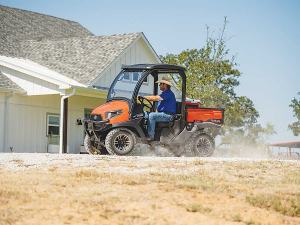Kubota to start field testing robotic tractor
Kubota has announced plans to start field testing the autonomous hydrogen powered fuel cell tractor it recently unveiled at Expo 25 in Osaka Japan.
 Kubota's new RTV 520 utility vehicle comes with a bold new look, increased suspension and an increase in engine capacity.
Kubota's new RTV 520 utility vehicle comes with a bold new look, increased suspension and an increase in engine capacity.
Kubota, which is gaining traction in the agricultural sector with an ever-broadening portfolio, has announced some additions for autumn.
The recently introduced M5-1 ROPS Series, available in standard or narrow configurations, should prove useful to those enterprises with height restrictions or a need to operate in enclosed spaces or on uneven surfaces.
It is powered by a 3.8 litre engine, offering 93 or 103hp, at an engine speed of 2,400rpm. The tractor has synchronised, six-speed transmission with three ranges and offering 36 speeds, which is said to offer a speed for any eventuality.
The operator station sees a flat floor layout, making access and dismounting easy. Meanwhile, the shorter stance of the tractor allows its driver to keep in close contact with colleagues who might be working close by, according to GM marketing for Australia and New Zealand, Malcolm Owens.
Another new addition to the Kubota range is the RTV 520 Utility vehicle. This machine draws on the tried and tested RTV 500, with a bold new look, increased suspension travel via a 5-link rear suspension package and an increase in engine capacity.
Featuring a hydrostatic transmission, the vehicle benefits from precise speed control and engine-braking while travelling on downhill inclines. Offering a choice of 2WD, 4WD and difflock, the new model uses a new water-cooled, twin cylinder engine. With output of 17.4hp, the new machine is as quiet as the previous model, with noise levels at the operator station kept to 83dBA.
Elsewhere in the range is the R540 compact wheeled loader, which replaces the Ro65 mode. The new model includes new features such as a redesigned cabin, multifunction joystick and increased load.
Its designers have paid special attention to operator comfort and machine stability and its 51hp engine meets Tier 4 final emission regulations.
"Additional space and a simple design helps to deliver better overall visibility in both the cabin and canopy formats," Owens adds. "While the new pilot-controlled joystick and its integrated auxiliary valve switch helps create a smoother operational experience."
Federated Farmers says almost 2000 farmers have signed a petition launched this month to urge the Government to step in and provide certainty while the badly broken resource consent system is fixed.
Zespri’s counter-seasonal Zespri Global Supply (ZGS) programme is underway with approximately 33 million trays, or 118,800 tonnes, expected this year from orchards throughout France, Italy, Greece, Korea, and Japan.
Animal owners can help protect life-saving antibiotics from resistant bacteria by keeping their animals healthy, says the New Zealand Veterinary Association.
According to analysis by the Meat Industry Association (MIA), New Zealand red meat exports reached $827 million in October, a 27% increase on the same period last year.
The black and white coat of Holstein- Friesian cows is globally recognised as a symbol of dairy farming and a defining trait of domestic cattle. But until recently, scientists didn’t know which genes were responsible for the Holstein’s spots.
According to the New Zealand Dairy Statistics 2024/25 report, New Zealand dairy farmers are achieving more with fewer cows.